捷进英语1Unit3电子教案
- 格式:doc
- 大小:203.50 KB
- 文档页数:5
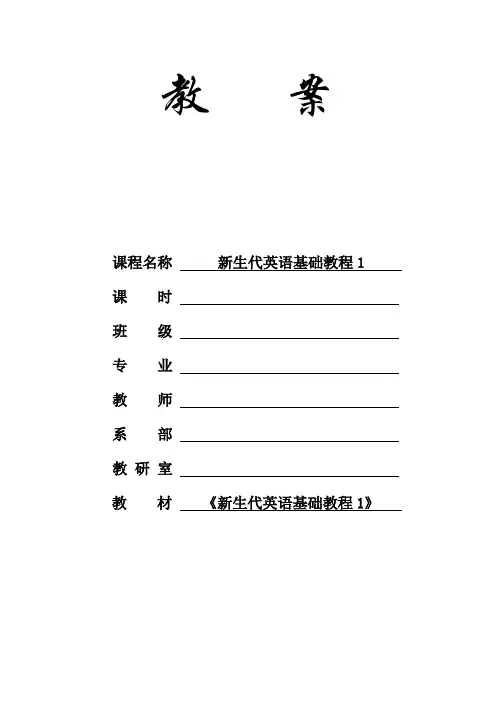
教案课程名称新生代英语基础教程1 课时班级专业教师系部教研室教材《新生代英语基础教程1》补充教学资源VOCABULARY BUILDER➢参考译文SHOW TIME➢语言解析1. The menu looks good. 菜单看起来不错。
look这里用作系动词,意为“看起来”,其后可以加多种语言成分。
1)look+形容词e.g.The teacher looks happy. 老师看上去很高兴。
2)look+过去分词e.g. He looked surprised when he heard the news. 得知消息时他显得吃惊。
3)look+名词e.g. He looks a nice, honest man. 他看上去是个诚实的好人。
4)look+介词短语e.g. He looks in good health. 他看起来十分健康。
2. HECTOR : I’m really thirsty, too. I think I’ll have a soda.MATEO : Go ahead, knock yourself out.赫克托:我也很渴,我要再点个苏打水。
玛特奥:好吧! 你随便点。
knock yourself out.1)用餐时,当某人说“想点什么”,你可以用这句话回答,表示“随意点”。
2)当对方说自己想干什么事情的时候,可用此短语回答,包含的意思是“你可以做任何你想做的事情,不必客气”。
e.g. A: Can I borrow your pencil for a while?B: Knock yourself out. My pencil is just on the table.—我能借你的铅笔用一下吗?—请随便,我的铅笔就在桌子上。
3. Our special today is chicken and rice. 我们今天的特色菜是鸡肉米饭。
Special这里是“特色菜”,作名词用时,通常指“特别而不属于常态的事物”1)指“特色产品”e.g. Grocery stores have to offer enough specials to bring people into the store.杂货店为了招揽顾客不得不推出多种特色产品。
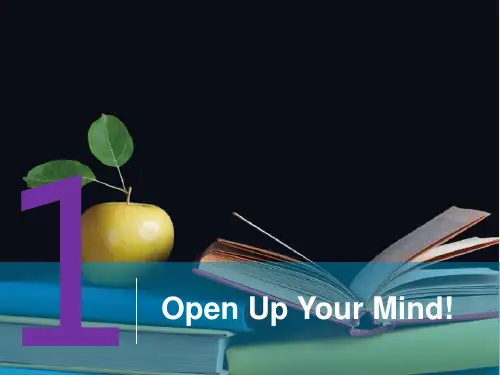
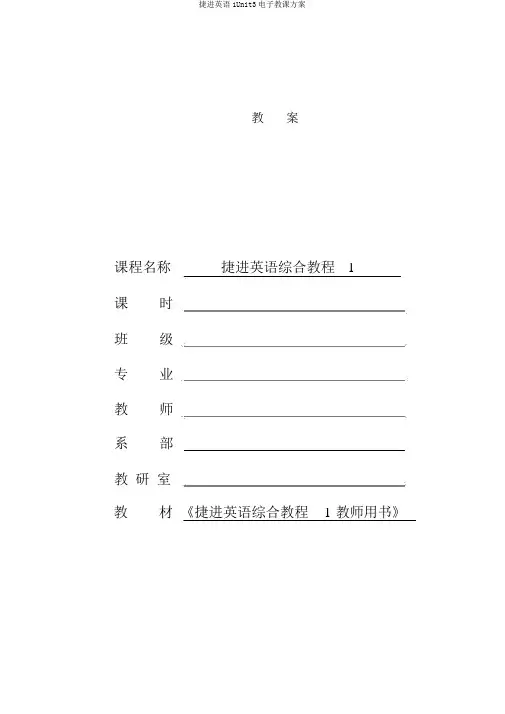
教案课程名称捷进英语综合教程1课时班级专业教师系部教研室教材《捷进英语综合教程 1 教师用书》Teaching Plan 教学单元单元主题教学内容Unit 3 Time TogetherDifficult partners along the journeyDifficult flatmatesLiving with othersReading for learningDriving Me MadReading for DoingPeople Are StrangeGuided WritingAn InvitationAudio/Video Lab课时8安排讲课环节主要特点讲课活动安排建议This section Depending on the time you haveWarm-up introduces the available,you could also ask students (热身)idea of to write their own sentencesteamwork and describing how they feel about workingworking withReading for learningother people.with others.It encouragesstudents tostart thinkingabout some ofthe advantageanddisadvantagesof teamwork.This section In Reading and Understanding ,you starts with could spend more time on Task1of recognising the identifying the main idea by first main idea. It allowing students to only read the then encourages topic sentence in each case before students to then checking their ideas by readingwrite a brief the whole text.Task2checks the summary of the students detailed understanding and main idea.Task 3 encourages summarising of theVocabulary andmain ideas.Grammar In Vocabulary Focus , Task 1 builds on Students look atthe theme of teamwork.Task 2 combines some challengingteamwork and travel and acts as good words and phrasespreparation for the Beyond the Text from the text. Tasktask. If you have time, you could2 gets them to usediscuss the students’ opinion of theReading(阅读)Readingfordoing the words in a realworld context andTask 3 tests theirability tounderstand somecommon collocates.The grammar sectionworks on the pastperfect, a usefultext for narratingevents.Beyond the TextStudents look at arange of adventuretrips.Students read areflectivearticle on aperson ’sexperiences ofliving withother people.An invitation:(1) rejectingtrip.The Grammar Focus part looks at thepast perfect. After focusing on theform students then practise using thestructure in the context of travel andteamwork.Beyond the Text students look at arange of trips they could make thatreflect, in a simple way, thechallenges of the reading text.If you have more time, you couldhighlight some of the structures usedfor giving advice. Students mightfindthis useful when they move onto thevideo section.Before students read the letters youcould brainstorm a range of contextsGuided Writing Audio/Video LabWrap-up invitations for inviting people out.(2) signing off When checking Task 2 highlight theformal / cautious nature of rejecting.With weaker students you might want toshow them the model first before theywrite their invitation.Students watch a Write flatmate onto the board and ask video showing students to discuss their experiencesome of the of living with others.difficulties ofFor each part of the video you might living withwant to play it twice.others:Students might need more support with (1) listening forTask 5 and Task 6. With weaker classes, feelingsprovide some phrases or sentences on (2) listening for the board to help them.apologiesThis section Task 1 should be set as pair work. Task provides a quick 2 and Task 3 could be set as homeworkreview of the or as a competitive game.vocabulary,Task 4 and Task 5 should be set as small grammar,group discussion tasks.writing andtheme of theunit.作业课后总结与反思Tasks could beset forindividual workor done inpairs.课后学习设计Finish all the exercises in Unit 3.Read the two texts in this unit again and try to summarise their contents.Make a plan for your travel in the near future.。
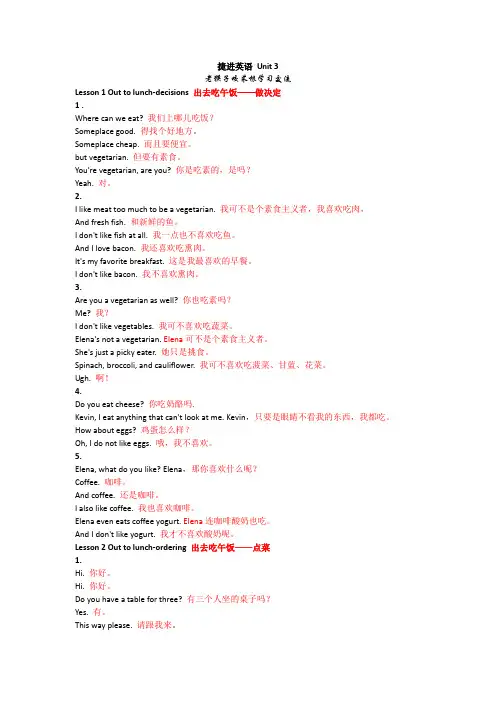
捷进英语Unit 3老猴子咬菜根学习交流Lesson 1 Out to lunch-decisions 出去吃午饭——做决定1 .Where can we eat? 我们上哪儿吃饭?Someplace good. 得找个好地方。
Someplace cheap. 而且要便宜。
but vegetarian. 但要有素食。
You're vegetarian, are you? 你是吃素的,是吗?Yeah.对。
2.I like meat too much to be a vegetarian. 我可不是个素食主义者,我喜欢吃肉,And fresh fish. 和新鲜的鱼。
I don't like fish at all. 我一点也不喜欢吃鱼。
And I love bacon. 我还喜欢吃熏肉。
It's my favorite breakfast. 这是我最喜欢的早餐。
I don't like bacon. 我不喜欢熏肉。
3.Are you a vegetarian as well? 你也吃素吗?Me? 我?I don't like vegetables. 我可不喜欢吃蔬菜。
Elena's not a vegetarian. Elena可不是个素食主义者。
She's just a picky eater. 她只是挑食。
Spinach, broccoli, and cauliflower. 我可不喜欢吃菠菜、甘蓝、花菜。
Ugh. 啊!4.Do you eat cheese? 你吃奶酪吗.Kevin, I eat anything that can't look at me. Kevin,只要是眼睛不看我的东西,我都吃。
How about eggs? 鸡蛋怎么样?Oh, I do not like eggs. 哦,我不喜欢。
5.Elena, what do you like? Elena,那你喜欢什么呢?Coffee. 咖啡。
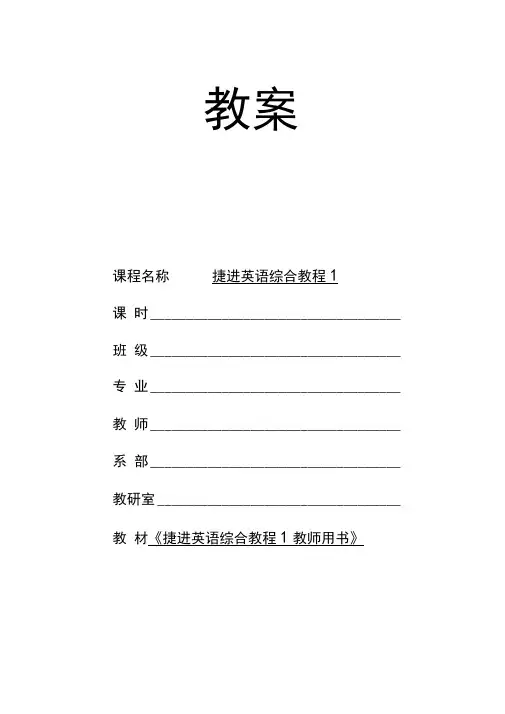
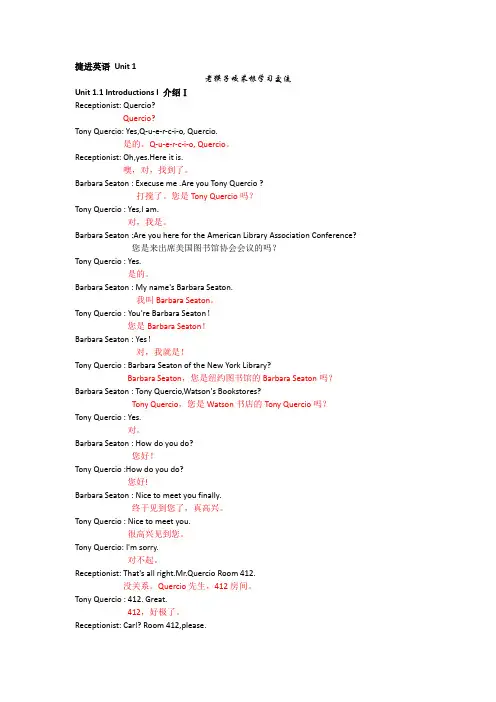
捷进英语Unit 1老猴子咬菜根学习交流Unit 1.1 Introductions I 介绍ⅠReceptionist: Quercio?Quercio?Tony Quercio: Yes,Q-u-e-r-c-i-o, Quercio.是的。
Q-u-e-r-c-i-o, Quercio。
Receptionist: Oh,yes.Here it is.噢,对,找到了。
Barbara Seaton : Execuse me .Are you Tony Quercio ?打搅了。
您是Tony Quercio吗?Tony Quercio : Yes,I am.对,我是。
Barbara Seaton :Are you here for the American Library Association Conference?您是来出席美国图书馆协会会议的吗?Tony Quercio : Yes.是的。
Barbara Seaton : My name's Barbara Seaton.我叫Barbara Seaton。
Tony Quercio : You're Barbara Seaton!您是Barbara Seaton!Barbara Seaton : Yes!对,我就是!Tony Quercio : Barbara Seaton of the New York Library?Barbara Seaton,您是纽约图书馆的Barbara Seaton吗?Barbara Seaton : Tony Quercio,Watson's Bookstores?Tony Quercio,您是Watson书店的Tony Quercio吗?Tony Quercio : Yes.对。
Barbara Seaton : How do you do?您好!Tony Quercio :How do you do?您好!Barbara Seaton : Nice to meet you finally.终于见到您了,真高兴。
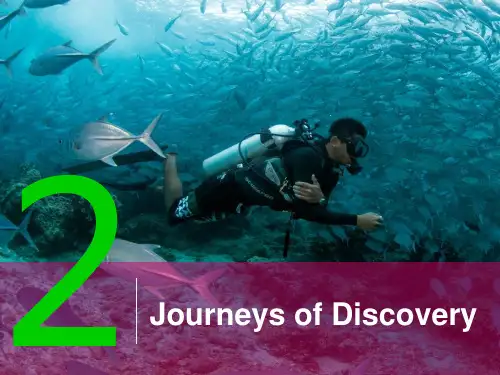

Lesson 3 Is it a pig?一、教学内容和要求(Teaching contents and demands)二、难点分析(Analyses of teaching contents)1.语音(Phonetics)本课重点学习i, o, u的短音,同时复习a的短音和e的短音,要掌握单音的读法并能够拼读含i, o, u的短音的单词,同时与a, e的短音进行对比,复习巩固,加深印象。
本课还学习了字母组合sh,ck的发音。
字母c和字母组合ck在单词中的读音和字母k一样,都读作k。
字母组合sh的发音,可借助于汉语拼音进行学习,口诀是“师傅,汉语sh, 英语sh, sh, sh”,汉语拼音sh发音时有韵母i,不噘嘴,而英语读音要去掉韵母,同时噘嘴。
字母x的读音,可以采用掐头法,将x名称音中的第一个音去掉,即可得到x在单词中的读音/ks/。
2.词汇(Words)本课共有16个生词,这些生词除fox外都要求四会,含有i的短音的生词有it, is, pig等,含o的短音的生词有not, dog等,含有u的短音的单词有bus, run, duck等。
3.语言结构(Structure)本课的重点语言结构是Is it a pig? Yes, it is. It is not a fox. It抯 a dog. Cana duck swim? Yes, it can.本课学习情态动词can的用法,学习其一般疑问句及其肯定回答。
通过学习,学生要能够理解和掌握can表示能力的用法,并能够运用这一用法表达“我能做什么”。
前面几课都是在学习主系表结构,本课首次出现了含有实义动词的句子,教师在教学中要注意引导。
而含有实义动词的句子中,can句型又是其中比较简单的,因此教师只要让学生知道句子结构即可,不必过多讲解。
本课Let抯talk既是学习新句型,同时也是对本课语音、词汇的进一步复习巩固和运用,真正做到语音、词汇、语言结构相结合,在语流中学语音。
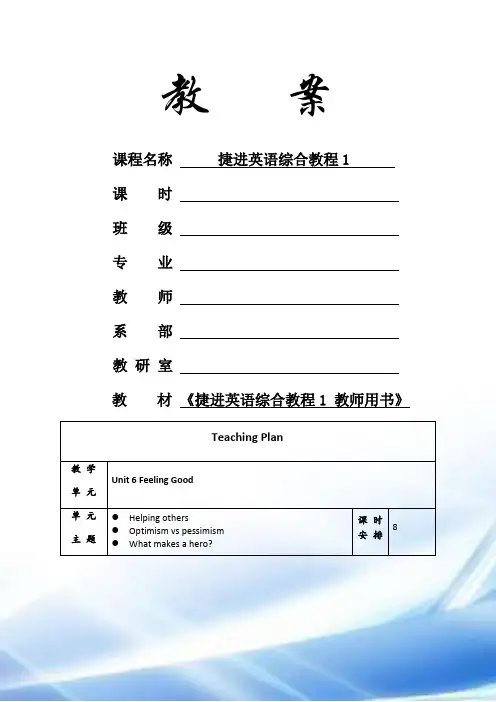
教案课程名称捷进英语综合教程1课时班级专业教师系部教研室教材《捷进英语综合教程1 教师用书》Teaching Plan教学单元Unit 6 Feeling Good单元主题●Helping others●Optimism vs pessimism●What makes a hero?课时安排8教学内容●Reading for learningWould You Like to Make a Difference?●Reading for DoingHalf Full or Half Empty?●Guided WritingA Letter of Thanks●Audio/Video Lab教学环节主要特色教学活动安排建议Warm-up(热身)This section introducesthe idea of feelings andreactions. It does thisthrough a set ofadjectives and musicclips for students toreact to.✧Depending on the time you have available,you could extend this into students playingtheir own music and discussing how themusic makes them feel.Reading (阅读)Readingforlearning◆This section startswith usingpronoun referentswhen reading tohelp understandthe organisation ofa text. It thenencouragesstudents to workout reasons in thetext.◆Vocabulary andGrammarStudents look atphrases and individualwords from the text.The grammar focus✧In Task 4 of Reading and Understanding,you could ask students to compare theirtranslations with a partner. Then ask studentsto close their books and translate them backinto English.✧In Vocabulary Focus, the three vocabularytasks draw on the text. Task 1 and Task 3 arealso a set of questions and so work well aspair-work discussion tasks.✧The Grammar Focus part looks at differentways of referring to the past, present andfuture with quite simple structures. Afterworking through the tasks you would setstudents a short written or spoken task usingthese structures to refer to their own desiresin the past present and future.✧Beyond the Text encourages students to reactlooks at would like to, like to and wanted to.◆Beyond the TextStudents interpret their own decisions. personally to the texts they have read. It also practices the grammar structure. Students could also think about and discuss their own good deeds.Reading for doing ◆Students read andanswer aquestionnaire onoptimism andpessimism.✧This section should take less time thansection A as the text is less complicated.They focus on developing students’ everydayreading skills as they are reading andresponding to a questionnaire.✧If time permits, students could create theirown scenario and options for others tochoose as an additional question in thequestionnaire.Guided Writing ◆Writing a letter ofthanks:(1) Formal expressionsof thanks(2) Informalexpressions ofthanks ✧When checking Task, 2 you could highlightsome of the other features of informality aswell as the vocabulary / phrases focused on,e.g. the punctuation and contractions.✧With weaker students you might want toshow them the model first before they writetheir email.Audio/Video Lab ◆Students watch avideo showingan interviewwith someonewho has donesomethingheroic:(1) making predictions(2) dictating andansweringquestions ✧Write hero onto the board and ask students todefine the word and to think of an example of one.✧When you get to Task 5, you will probablyneed to pause briefly between each question.Wrap-up ◆This sectionprovides a quickreview of thevocabulary,grammar, writing ✧For Task 1, Task 2 and Task 3 on thelanguage work, you might want to set themup as a team game or class quiz.✧For Task 4, it could be set as small groupand theme of theunit.◆Tasks could be setfor individualwork or done inpairs.discussion task.课后学习设计作业◆Finish all the exercises in Unit 6.◆Read the two texts in this unit again and try to summarisetheir contents.◆Write a letter of thanks to a person who ever helped you.课后总结和反思。

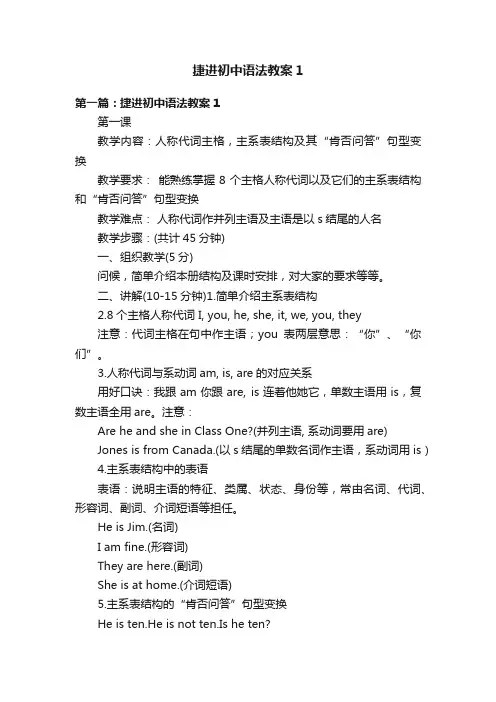
捷进初中语法教案1第一篇:捷进初中语法教案1第一课教学内容:人称代词主格,主系表结构及其“肯否问答”句型变换教学要求:能熟练掌握8个主格人称代词以及它们的主系表结构和“肯否问答”句型变换教学难点:人称代词作并列主语及主语是以s结尾的人名教学步骤:(共计45分钟)一、组织教学(5分)问候,简单介绍本册结构及课时安排,对大家的要求等等。
二、讲解(10-15分钟)1.简单介绍主系表结构2.8个主格人称代词 I, you, he, she, it, we, you, they注意:代词主格在句中作主语;you表两层意思:“你”、“你们”。
3.人称代词与系动词am, is, are的对应关系用好口诀:我跟am你跟are, is连着他她它,单数主语用is,复数主语全用are。
注意:Are he and she in Class One?(并列主语, 系动词要用are)Jones is from Canada.(以s结尾的单数名词作主语,系动词用is)4.主系表结构中的表语表语:说明主语的特征、类属、状态、身份等,常由名词、代词、形容词、副词、介词短语等担任。
He is Jim.(名词)I am fine.(形容词)They are here.(副词)She is at home.(介词短语)5.主系表结构的“肯否问答”句型变换He is ten.He is not ten.Is he ten?Yes, he is./ No, he isn’t.用好口诀:“变疑问,be提前,句末问号别忘记”;“变否定,更容易,be加not要牢记”。
提问: She is nine.(变否定句、疑问句,并作简答。
)注意以下两点:⑴ 主语为I/we/you时,变疑问句还可以这样变(有两种形式),如:right?⑵ 否定形式: is和are有三种形式,但am只有两种,I am old.→ Am I old? / Are you old?You are right.→ Are you right? / Am I 如:He isn’t.../ He’s not.../ He is not...I’m not.../ I am not...解释:is和are都可以直接和not构成缩略形式isn’t和aren’t,但am不可,没有amn’t这种形式。
捷进英语1U n i t3电子
教案
-CAL-FENGHAI-(2020YEAR-YICAI)_JINGBIAN
教案
课程名称捷进英语综合教程1
课时
班级
专业
教师
系部
教研室
教材《捷进英语综合教程1 教师用书》
Difficult partners along the journey Difficult flatmates
Living with others
Reading for learning
Driving Me Mad
Reading for Doing
People Are Strange
Guided Writing
An Invitation
Audio/Video Lab
This section introduces the idea of teamwork and working with other people. It encourages students to start thinking about some of the advantage and disadvantages of teamwork.Depending on the time you have available, you could also ask students to write their own sentences describing how they feel about working with others.
This section starts
with recognising
the main idea. It
then encourages
students to write
a brief summary
of the main idea.
Vocabulary and
Grammar Students look at some challenging words and phrases from the text. Task 2 gets them to use the words in a real world context and Task 3 tests their ability to In Reading and Understanding, you could spend more time on Task 1 of identifying the main idea by first allowing students to only read the topic sentence in each case before then checking their ideas by reading the whole text. Task 2 checks the students detailed understanding and Task 3 encourages summarising of the main ideas. In Vocabulary Focus, Task 1 builds on the theme of teamwork. Task 2 combines teamwork and travel and acts as good preparation for the Beyond the Text task. If you have time, you could discuss the students’ opinion of the trip.
The Grammar Focus part looks at the past
understand some common collocates. The grammar section works on the past perfect, a useful text for narrating events.
Beyond the Text Students look at a range of adventure trips.perfect. After focusing on the form students then practise using the structure in the context of travel and teamwork.
Beyond the Text students look at a range of trips they could make that reflect, in a simple way, the challenges of the reading text.
Students read a reflective article on a person’s experiences of living with other people.If you have more time, you could highlight some of the structures used for giving advice. Students might find this useful when they move onto the video section.
An invitation:
(1) rejecting invitations
(2) signing off Before students read the letters you could brainstorm a range of contexts for inviting people out.
When checking Task 2 highlight the formal / cautious nature of rejecting.
With weaker students you might want to show them the model first before they write their invitation.
Students watch a
video showing
some of the
difficulties of
living with others: (1) listening for
feelings
(2) listening for
apologies Write flatmate onto the board and ask students to discuss their experience of living with others.
For each part of the video you might want to play it twice.
Students might need more support with Task 5 and Task 6. With weaker classes, provide some phrases or sentences on the board to help them.
This section provides a quick review of the vocabulary, grammar, writing and theme of the unit.
Tasks could be set for individual work or done in pairs. Task 1 should be set as pair work. Task 2 and Task 3 could be set as homework or as a competitive game.
Task 4 and Task 5 should be set as small group discussion tasks.
Finish all the exercises in Unit 3.
Read the two texts in this unit again and try to summarise their contents.
Make a plan for your travel in the near future.。